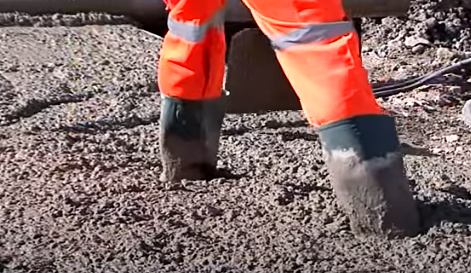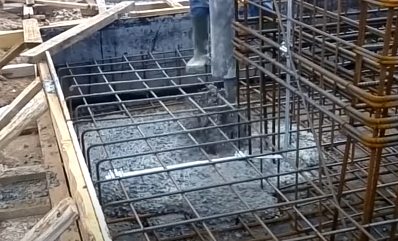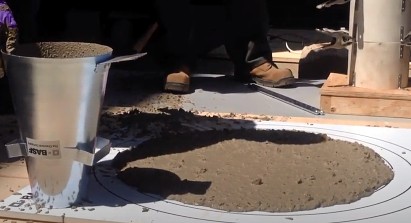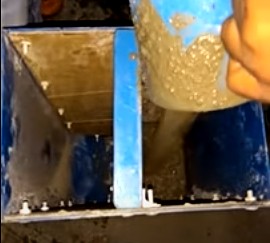Self compacting concrete(SCC), also known as self-consolidating concrete, is a special concrete mix exhibiting high flowability, good segregation resistance, and ability to self-compact and consolidate under its own weight without application of any means of mechanical vibration and tamping.
In addition, Self compacting concrete has low yield stress, high deformability, moderate viscosity, and high stability characteristics that enhance its property in both a fresh and hardened state.

Traditional concrete mixes (cement-sand-aggregate-water and water resistance admixture) used in general practices are dense and viscous in nature. This causes the formation of smaller air voids, cavities, and large honeycomb voids while pouring in the formworks, thus requiring mechanical vibration to remove such cavities and voids.
On the other hand, the use of additional water to increase the workability of such concrete results in bleeding and the formation of air voids when excess water dries off.
In addition, excess mechanical vibration results in the segregation of concrete contents and the formation of cracks and microvoids between the joints of coarse aggregate and hardened cement sand paste which deteriorate the strength of hardened concrete.
In contrast to traditional concrete, additional special admixtures like superplasticizer, viscosity modifiers, and filler minerals are added in the SCC mix in order to reduce segregation and bleeding while enhances the flow and filling ability of the mix.
According to the experiments and scientific research, the SSC mix with a similar water-cement ratio to that of the traditional vibrated concrete mix has been found to have slightly higher strength parameters, due to the fact that mechanical vibration interferes with the interface between the aggregate and hardened paste making the bond weaker.
Application of Self-Compacting Concrete
Method of application of SCC: SCC mix should be poured at a relatively higher velocity than that of traditional concrete mix. It has been recorded to have been poured from a height taller than 5 meters without segregation and in a densely reinforced portion with an aggregate size of 2 inches.

The self-compacting concrete are mostly used in following areas under following conditions:
- Construction of concrete structures with a high concentration of rebar and pipes/ and structures with limited possibility of compaction in case of use of regular concrete mix.
- Used in repairs works, restoration and renewal construction
- Construction of highly stable and durable Retaining structures
- Construction of raft, pile foundations, and drilled shafts
- Self-compacting concrete is used in the construction of structure where high surface quality is required (filigree structure)
- SCC is used in the construction of structures in a high noise-sensitive area
- SCC is widely used in precast industries(economical)
Akashi-Kaikyo Suspension Bridge/ pearl bridge in Japan is the most remarkable example of a structure constructed using SCC which completed its construction a half year earlier than expected.
Materials used in Self compacting concrete
The materials used in design of SCC are listed as follows:
1. Cement
Ordinary Portland cement of either 43 or 53 grade cement can be used as a binding material.
2. Aggregates
Coarse aggregates of size up to 20mm(1inch) are considered suitable for the design of the SCC mix. Whereas in the case of structures with highly concentrated reinforcements the aggregate size ranging from 10 to 12mm can be used. Well, graded aggregates of round or cubical shape are preferred for the mix.
Uniformly graded fine aggregates (natural or manufactured) with particle size less than 0.125mm are preferred.
3. Water
Water used should not contain any sorts of impurities that may negatively impact the reinforcements and concrete contents.
4. Mineral Admixtures
On the basis of mix design and properties required, various mineral admixtures that can be used in the SCC mix which are listed below along with their respective properties imparted to the concrete
- Ground Granulated Blast Furnace Slag (GGBS): The addition of GGBS helps to improve the rheological properties (deformation and flow characteristics) of the fresh SCC.
- Fly ash: The addition of Fine fly ash particles improves the filling property of the concrete thus helping in filling the internal concrete matrix with pores. This overall improves the quality and durability of the self-compacting concrete structures
- Silica Fumes: The addition of Silica fumes increase the mechanical properties of the SCC structures.
- Stone Powder: Addition of stone powder in SCC improves the powder content of the mix
These mineral admixtures (<80um) are also termed as filler or supplementary cementitious materials to improve the workability and ultimate strength parameters of SCC.
Additions of these fine filler material along with the fine aggregates increase the total fine material count in SCC up to 50% of total aggregate concrete which is considered as an appropriate ratio.
5. Chemical Admixtures
Superplasticizers and viscosity modifying admixtures are used in the SCC mix to enhance the flowability and stability of SCC. These admixtures work well in the presence of high powder materials (mineral admixtures) and well-graded aggregates.
Additionally, retarders are added to control the setting time along with water reducers to reduce free water. Air entraining agents can also be used to increase thaw or frost resistance.
The type and proportion of the above-mentioned materials may vary from one location to another on the basis of climatic conditions, surrounding temperature, material availability, and properties. The quality and proportion of the above mention constituent greatly affect the properties and nature of SCC
Properties of Self compacting concrete
The key engineering attributes of SCC in the fresh state which separate it from traditional vibrated concrete are listed as follows:
- Filling Ability: This property describes the ability of the concrete to flow under its own weight without the application of mechanical vibration.
- Passing Ability: This property describes the ability of the concrete to maintain its homogeneity throughout the structure.
- Segregation resistance: This property measures the resistance of the concrete to prevent segregation when it flows under its own weight during the self-compaction process.
Test conducted on Self compacting concrete
Various tests are conducted to determine the key properties of the SCC in its fresh state which are categorized as follows
Table.1: Different Tests conducted on Self Compacted Concrete

The Standard tests conducted for determining each property of the SCC in fresh state are as follows
1) Slump flow test to determine the filling ability of the SCC

The slump flow test is a simple, rapid, and most commonly used test to determine the horizontal free flow characteristics of the SCC mix in the absence of any obstacles. This test gives a good assessment of filling ability and indication of resistance to segregation up to a certain extent.
The T represents the diameter of circle made by concrete which gives measure of the filling ability of the self compacting concrete mix.
Apparatus required and test requirement
- Truncated slump cone of internal diameter 200mm at bottom and 100mm at top and a height of 300m.
- A rigid, watertight, smooth base plate which is approximately 0.8m*0.8m or larger in size and made out of steel or other non-water absorbing materials Center point for the slump cone and a circle of 500mm can be marked on the base plate to guide the flow
- Measuring tape (LC 1mm), trowel, scoop and stopwatch (LC 0.1sec)
- About 6 liters of the sample is required
Procedure
- Wipe the internal surfaces of the slump cone and base plate using a wet cloth
- Place the base plate on a stable leveled ground and slump cone on the base plate centrally
- Fill the slump cone with a sample SCC mix with a scoop within 2 minutes. Sample must be evenly distributed all over the cone up to the height of 300mm (up to the brim)
- Level off the top surface of the concrete with a trowel and immediately raise the cone vertically up to a height of 300mm within 2-3 seconds without any interruption and simultaneously start the stopwatch
- Allow the concrete to flow freely and note the time at which concrete reaches the 500mm circle mark and the time at which the flow visually stops along with its diameter (maximum diameter and diameter perpendicular to maximum diameter)
- If the diameters (right angle diameters) at the end of the flow varies more than 50mm then the test shall be conducted again with the same batch of sample
Result
The T500mm time indicates the flowability of the SCC sample. Lower the T 500mm time grater the flowability. The acceptable time for T500mm ranges from 3 -7 seconds. Furthermore, if coarse aggregates remain in the center of the pool of concrete and cement-sand paste at the periphery it indicates the occurrence of segregation.
2) Passing ability test using U-shaped Box apparatus

U-shaped box test is a simple and commonly used to determine the passing ability of the SCC mix design.
Apparatus required
- U shaped container: It is a U-shaped rigid container (usually transparent) having smooth internal surfaces. It consists of a partition plate with flow obstacle made out of vertically arranged deformed bars (like a fence) at the bottom along with a sliding gate at the groove in the center. The partition plate divides the box into two compartments say A and B. A sampling gate is provided at the compartment B to measure the coarse aggregate content after the sample has passed from A to B room through the obstacle.
- The obstacles are of two types: Obstacle R1 with 5no. of D10 deformed bar @ 35mm and Obstacle R2 (normally used) with 3 no. of D13 deformed bar @ 35mm spacing. Choice also depends on reinforcement condition in structure
- Straightedge for leveling the top surface, measuring tape (LC=1mm), stopwatch (LC=0.1sec)
- Container for charging the sample
Procedure
- Fix the U-shaped container vertical with its top edge leveled at horizontal.
- Place the sliding gate and partition plate with an obstacle into the U-shaped container forming two compartments say A and B
- Clean the internal surfaces of the container, sliding gate, partition plate, and obstacle fence with a wet cloth piece.
- Pour the sample concrete continuously up to the top edge of Room A using a charging jug with the sliding gate closed. Any sort of compaction or disturbance is prohibited.
- Trim off the excess sample with the help of a straightedge or trowel
- Level the sample with the top edge of the container using a trowel or straight edge and leave it to stand for 1 minute without any disturbance.
- Then open the sliding gate in an instant, allowing the concrete to flow through the obstacle into Room B.
- Leave the container to stand until the concrete flow stops.
- Measure the height of concrete-filled in Room B from the bottom of the container using a measuring tape having 1 mm least count. Say, fill height = Bh (mm). It is recommended to measure the height at three points, i.e. at the center of the container and two corners.
- Measure the time from the opening of the sliding gate to the end of filling into Room B using a stopwatch with LC = 0.1sec. say filling time = B time (sec).
- For determining the coarse aggregate content of the concrete after passing through the obstacle fence, a sample can be taken out from the sampling gate provided at room B. The coarse aggregate content, mG (g), can be determined using the method for washing analysis of fresh concrete.
Result
- Filling time = B time in second up to 1/10th of a second
- Fill height = average of the three fill height = Bh in mm up to first decimal place after average calculation
- Coarse aggregate mass ratio = mG/mGO
- Where, mG = coarse aggregate content after passing through an obstacle in kg/m3
- mG = coarse aggregate content in the mix design sample before passing in kg/m3
3) V funnel test

V funnel test is conducted to determine the average flow-through speed, relative flow through speed, and flow through indices of the SCC with maximum coarse aggregate size 25mm or less. These value can be evaluated to determine the filling ability and segregation resistance of SCC
Apparatus required
- V-shaped funnel apparatus: It consists of a V-shaped funnel and stands support. The smaller outlet orifice of the funnel is provided with a watertight gate that can be opened instantaneously.
- Sizes top orifice ((490 or 500) mm* 75mm, outlet orifice (65 or 75) mm * 75mm, sloping of funnel V:H=2:1, Height of sloping surface = 425, length of outlet portion = 150mm
- A charging mug of 5-liter capacity, a receiving container, straight edge for leveling the top surface, stopwatch with LC = 0.1second.
Procedure
- Wash the V-shaped funnel with water and set it vertically with the help of the stand support with its top edge being horizontally leveled.
- Wipe the internal surface of the funnel with a tightly squeezed wet cloth maintaining certain moisture on the surface.
- Place a receiving container under the orifice of the funnel and close the trap.
- Pour the SCC mix sample into the funnel up to its top edge using a charging mug.
- Trim off the excess concrete and level the top surface of the concrete with the top edge of the funnel using a straightedge.
- After leveling the top surface, open the trap within 10 seconds
- Then measure the time from the moment of opening of the trap to the moment when all the concrete comes out of the funnel, using a stopwatch with LC = 0.1sec0. Say time taken for the concrete to totally flow out of the outlet is t0.
- Along with this, observe and record the state of flowing i.e. whether the concrete tended to clog up during flowing.
- To determine the flow-through index, fill the funnel with another sample as mentioned in the above steps, and leave it to stand for 5 minutes.
- After 5 min elapses open the trap and let the sample flow out of the funnel until the funnel becomes empty. The flow-through time measured in this case be t5. Also, record the state of flowing during testing.
- It is desirable to measure the flow-through 2 or more times within the time frame of 5 minutes using different samples. The funnel should be washed thoroughly on each subsequent test. Average flow through time is calculated out of the total number of tests conducted to obtain more accurate data.
- Concrete with a low segregation resistance results in the large variation in flow-through time between two subsequent tests. This helps to determine the degree of segregation up to a certain extent.
Result
- Calculate the average flow through time using all the flow-through time data obtained from the subsequent tests.
- Calculate the average flow-through speed at the orifice by the following equation.
For V-funnel, Vm = 2.05 / t0
where, Vm = average flow-through speed (m/s)
t0 = flow-through time (second-up to second digit after decimal after obtaining average value)
value 2.05 obtained by dividing the volume of 0.01m3 by the cross-sectional area of outlet orifices ((65-75) mm*75mm).
- Calculate the relative flow-through speed by using the following equation.
Rm =10 / t0
Where, Rm = relative flow-through speed
t0 = flow-through time (sec up to 2 digits after decimal after calculation of average time)
- Calculate the flow-through index by using following equation
flow-through times measured under two test conditions:
Sf = (t5 – t0) / t0
where Sf = flow-through index
t0, t5 = flow-through time (s)
if t5 < t0, then Sf is assumed to be zero.
These values evaluate the filling and flowability of the SCC and also give some extent of information on segregation resistance as mentioned above.
Mix design requirements
1. High Volume of Paste
An increase in paste content (a combination of cement water, additives, and air) in SCC mix design reduces the friction between the aggregates resulting in separation of the aggregates and easy movement of the mix. This helps the SCC to attain adequate passing ability. The volume of the paste in the range of 300 to 400 l/m³ is recommended.
2. High Volume of Fines (<80µm)
An increase in the volume of fine materials (cements and mineral admixtures) enhances the workability of SCC and helps it to undergo self-compaction. An increase in such workability may bring out issues of segregation and bleeding. To limit such risks, the recommended volume of fines to be used in the design of SCC is in the range of 500 kg/ m3. The durability and strength requirements of the concrete also determine the volume of the fines to be added.
3. High Dosage of Superplasticizers
The addition of an adequate amount of superplasticizers in addition to fine content increases the fluidity and workability of the SCC. Whereas a high dosage of such admixture will lead to segregation or bleeding issues.
4. Use of Viscosity Modifying Agent
The addition of viscosity modifying agent enhances the flowability of SCC without causing segregation and bleeding issues. These help to hold the mix by thickening the paste and by holding the water inside the paste. Viscosity modifying agents make SCC less sensitive to water variations due to the water content present in the aggregates.
Cellulose derivatives, polysaccharides, or colloidal suspensions can be used as viscosity modifying agents. The addition of such admixture is recommended for SCC with a higher W/c ratio rather than for high-performance concrete with a lower w/c ratio.
5. Less Coarse Aggregate
It is recommended to use the coarse aggregates of sizes ranging from 10mm to 20mm. The increase in coarse aggregate reduces the passing ability of the SCC.
Thus, the recommend coarse aggregate content in the mix should be less which should not exceed more than 50% of total aggregate content. In contrast, larger aggregates sizes can be used in structures with a low concentration of reinforcement.
6. Addition of Admixtures
Admixtures can impart various effects on the strength, setting time, and temperature parameters of the concrete in both fresh and hardened state. The admixture type may vary along with the weather and temperature condition. Such admixture should be used only by following the guideline provided.
Factors Affecting Performance of Self compacting concrete
Using self-compacting concrete must not be used indiscriminately. These factors can affect the behavior and performance of self-compacting concrete:
- An increase in the working temperature highly decreases the flowability and fluidity of the SCC as it causes the mix to dry off quickly.
- Long haul distances also result in a reduction of flowability of SCC
- SCC mix design performance is also gravely affected by the delayed in site jobs like casting.
- Job site water addition in order to increase workability may affect the stability of the self-compacting concrete.
- Application of mechanical compacting unknowingly or intentionally result in loss of strength parameters and issues like bleeding and segregation.
Special Considerations for SCC
Special consideration required to be focused on the application of SCC are as follows
- Spillage of SCC during hauling may produce severe environmental contamination and hazards.
- Formwork is required to be designed to withstand the higher fluid concrete pressure than that of regular concrete which results in expensive formworks
- Self compacting concrete mix design requires more skilled manpower and care.
- Power full pumps and lift may be required for the casting of taller elements
- Construction cost per square increases with the use of SCC
- Advantages of Self Compacting Concrete
Advantages of Self compacting concrete
- Minimize the voids and cavities in highly reinforced areas
- Prevent honeycombing of concrete as a result of even distribution of concrete within the formworks
- Reduction of voids and cracks results in lower permeability of the concrete structure
- No extra manpower and vibration equipment are required for compactions and placing
- Problems arising due to vibration are highly reduced (micro-crack, bleeding, segregation)
- Reduces noise pollution arising due to the use of vibrators
- Self compacting concrete produces a surface finish of superior quality
- Durability and strength parameter of SCC structure is superior in comparison to regular concrete
- Improves structural integrity
- The casting of the complex structure becomes convenient
- Accelerates the construction speed and reduces the period of construction
- Can be used for a long span and deeper sections
- Use of industrial byproducts in the form of mineral admixture helps to reduce environmental pollution caused due to disposal of such byproducts (slag etc.)
Disadvantages of Self Compacting Concrete
Disadvantage of SCC are listed as follows
- Requires highly skilled manpower
- Requires precise measurements and monitoring which may not be possible in all situation
- More trial batches and lab tests are required for the mix design method
- More number of materials and admixture is required which becomes a tough situation when only limited resources are available
- Material selection of the self compacting concrete mix is stricter as a small change can alter the properties of concrete
- Requires more mixing action which increases the production cost of ready mix concrete
- As a result, SCC is costlier than regular vibrated concrete
Price of Self compacting concrete
Self-compacting concrete involves the selection of proper constituent material, the addition of admixtures, and complex mix design methods in comparison to regular concrete. In addition, it requires a lot of mixing plant and involves intensive mixing actions.
It also requires a lot of tests to be conducted on each batch resulting in losses if there are any mistakes in any batches. This results in SCC to become costlier in terms of production on-site or from the ready mix plant. On the other hand, in precast industries, SCC is found to be more economical due to mass production. It is estimated to be $50 costlier than the regular concrete per yard of structure.
I hope this article remains helpful for you.
Happy Learning – Civil Concept
Contributed by,
Civil Engineer – Jenish Shakya
Read Also,
Self Curing Concrete – Preparation, Application, advantage, disadvantage
Plain cement concrete (PCC)- Materials, Properties, and Mixing
How to stop water leakage from concrete roof? – Causes of Leakage
What causes concrete scaling? – Effects and Fixing of concrete scaling